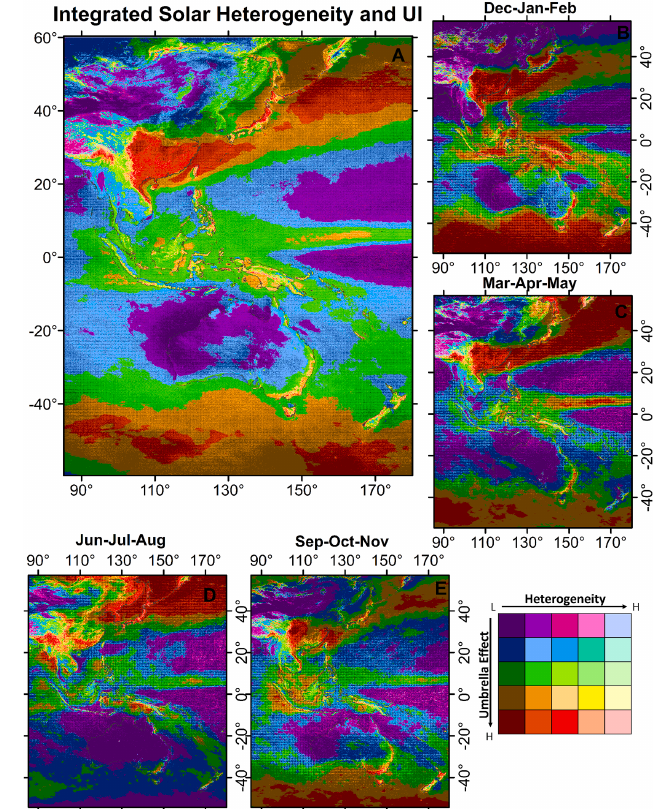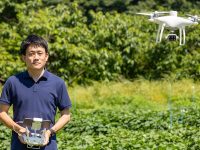Scientists investigate fluctuations of solar irradiance in time and space over the Asia Pacific region to help guide plans for solar power plants
Fluctuations in solar radiation are a problem for solar power plants as they cause problems in the power grid and other reliability issues. In a recent study, scientists from Japan and Indonesia aimed to deepen our understanding of variations in solar irradiance in time and space over the Asia Pacific region by analyzing satellite data. Their findings provide valuable insights that could help us optimize the position of future solar power plants.

Image title: Integrated annual/seasonal solar heterogeneity and the umbrella effect index (UI)
Image caption: These maps display spatial heterogeneity in solar irradiance and the impact of the umbrella effect on the Asia Pacific region during different times of the year. Using these data, the optimal location of solar power plants can be derived in terms of obtaining a stable and reliable power supply; these regions should have both low heterogeneity and a low umbrella effect index.
Image credit: Kalingga Titon Nur Ihsan from Chiba University and Institut Teknologi Bandung
Image license: CC BY 4.0
Usage restrictions: Credit must be given to the creator.
Amidst the ongoing energy crisis and under the threat of climate change, exploiting renewable energy sources has quickly become a global necessity. Though our options are varied, solar energy seems to be our best bet—experts estimate that it may become our main energy source well before the turn of the century.
Despite its clear advantages, solar energy generation has some limitations. Much like the wind, solar irradiance in a given region can vary quickly depending on weather conditions, causing fluctuations in power output. These fluctuations not only pose a problem for power grids but also imply that meeting energy demands may not always be a guarantee. Thus, having a clear understanding of the possible variations in solar irradiance in time and space is crucial to determining the optimal locations for solar power plants.
Against this backdrop, a research team led by Specially Appointed Assistant Professor Hideaki Takenaka from the Center for Environmental Remote Sensing, Chiba University, set out to extend our knowledge of solar irradiance over the Asia Pacific region. In their latest study, made available online on June 13, 2024, and published in Volume 276 of Solar Energy in July 2024, they conducted an in-depth analysis of solar irradiance data gathered from geostationary satellites. Other team members included Kalingga Titon Nur Ihsan, Graduate School of Science and Engineering, and Atsushi Higuchi, Center for Environmental Remote Sensing, both from Chiba University, as well as Anjar Dimara Sakti and Ketut Wikantika from the Center for Remote Sensing at Institut Teknologi Bandung.
The data for the analysis came from Himawari-8 and Himawari-9, two Japanese satellites that collect images with high temporal and spatial resolution over the Asia Pacific region. The researchers used AMATERASS solar radiation data obtained from quasi-real time analysis of solar radiation synchronized with geostationary satellite observation. They were developed by Dr. Takenaka and colleagues to accurately estimate solar irradiance via high-speed radiative transfer calculations using neural networks. AMATERASS operation started in July 2007, and analysis data was archived continuously for over 16 years. This data was made publicly available by the Chiba University, CEReS DAAC (Distributed Active Archive Center), downloaded 186,465,724 times, and used in various research and Japanese national projects. By leveraging this technology, the team estimated solar irradiance variability in terms of spatial and temporal heterogeneity. Simply put, they calculated how drastically solar radiation varies in space and time by analyzing solar irradiance data over a 20 km by 20 km grid every ten minutes.
Their analysis revealed interesting facts about solar irradiance over the region. For example, the team found that locations near the equator experienced lower fluctuations in solar irradiance over time compared to higher latitude regions due to the effects of rain and cloud activity. Moreover, regions of higher elevation exhibited higher heterogeneity due to higher cloud activity. The area around the Tibetan Plateau showed high seasonal changes in the magnitude of the ‘umbrella effect,’ which quantifies how much solar energy is reflected back to space. “Our evaluations based on spatiotemporal data revealed characteristics that would’ve been impossible to achieve using a traditional approach that relies on simple long-term averages or TMY (Typical Meteorological Year) as a typical solar irradiance data,” highlights Dr. Takenaka.
In addition to these insights, the research team assessed the performance of over 1,900 existing solar power plants using annual and seasonal data. They found that, due to umbrella effects caused by clouds, the production of a large portion of these plants is not optimum from June to August. This implies that the most affected zones should not rely entirely on solar power to meet increased demands during these months.
Finally, the researchers also investigated the optimal format for future solar power plants, concluding that more widely distributed solar energy generation is superior to more localized efforts. “Based on the spatial and temporal characteristics of solar irradiance, we suggest that it should be possible to suppress rapid fluctuations in solar power generation output by distributing small photovoltaic systems over a wide area rather than relying on large solar power plants,” explains Dr. Takenaka. “Worth noting, these conclusions come from weather and climate research, not an engineering perspective.” One way to achieve this vision might be through the use of rooftop solar panels, which is a growing trend in many countries.
Overall, the findings of this study will help us plan for the short- and long-term future of solar energy generation in the Asia Pacific region, bolstering sustainable energy technologies and aiding in our fight against climate change.
About Specially Appointed Assistant Professor Hideaki Takenaka
Hideaki Takenaka obtained a Ph.D. degree from Chiba University in 2009. He currently holds a special research and teaching position at the Center for Environmental Remote Sensing at Chiba University. His work focuses on solar energy, satellite remote sensing, solar radiation monitoring, and weather and climate science. He has published over 40 papers on these topics.
Funding:
This study was partly supported by the JST/JICA SATREPS BLUE project, JSPS 22H05004, and VL activities.
Reference:
Title of original paper: Solar irradiance variability around Asia Pacific: Spatial and temporal perspective for active use of solar energy
Authors: Kalingga Titon Nur Ihsan1,2,3, Hideaki Takenaka4, Atsushi Higuchi4,5,6,7,8,
Anjar Dimara Sakti3,9, and Ketut Wikantika3,9
Affiliations:
- Department of Environmental Remote Sensing, Graduate School of Science and Engineering, Chiba University
- Doctoral Program in Geodesy and Geomatic Engineering, Faculty of Earth Sciences and Technology, Institut Teknologi Bandung
- Center for Remote Sensing, Institut Teknologi Bandung
- Center for Environmental Remote Sensing (CEReS), Chiba University
- Research Institute of Disaster Medicine, Chiba University
- Typhoon Science and Technology Research Center (TRC), Yokohama National University
- National Institute of Information and Communications Technology (NICT)
- Solar Radiation Consortium
- Geographical Information Science and Technology, Faculty of Earth Sciences and Technology, Institut Teknologi Bandung
Journal: Solar Energy
DOI: 10.1016/j.solener.2024.112678
Contact: Hideaki Takenaka
Center for Environmental Remote Sensing, Chiba University
Email: takenaka@ceres.cr.chiba-u.ac.jp
Public Relations Office, Chiba University
Address: 1-33 Yayoi, Inage, Chiba 263-8522 JAPAN
Email: koho-press@chiba-u.jp
Tel: +81-43-290-2018
Recommend
-

Children-centered support and school operations: On the occasion of the founding of the Children and Families Agency
2023.02.15
-

Making the Invisible Visible: Drones Enabling Agricultural Advances
2022.10.17
-

A Day in the Life of a Sports DoctorProfessionals behind the world’s most prominent sporting events
2023.04.13


